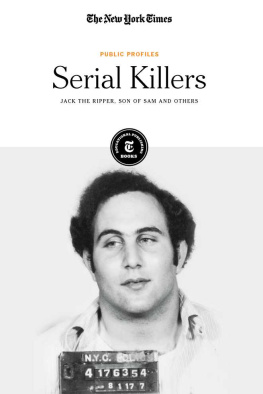Published in 2019 by New York Times Educational Publishing in association with The Rosen Publishing Group, Inc.
29 East 21st Street, New York, NY 10010
Contains material from The New York Times and is reprinted by permission. Copyright 2019 The New York Times. All rights reserved.
Rosen Publishing materials copyright 2019 The Rosen Publishing Group, Inc. All rights reserved. Distributed exclusively by Rosen Publishing.
First Edition
The New York Times
Alex Ward: Editorial Director, Book Development Phyllis Collazo: Photo Rights/Permissions Editor Heidi Giovine: Administrative Manager
Rosen Publishing
Megan Kellerman: Managing Editor Greg Tucker: Creative Director Brian Garvey: Art Director
Cataloging-in-Publication Data
Names: New York Times Company.
Title: Serial killers: Jack the Ripper, Son of Sam and others / edited by the New York Times editorial staff.
Description: New York : New York Times Educational Publishing, 2019. | Series: Public profiles | Includes glossary and index. Identifiers: ISBN 9781642821789 (library bound) | ISBN 9781642821772 (pbk.) | ISBN 9781642821796 (ebook) Subjects: LCSH: Serial murdersJuvenile literature. | Serial murderersJuvenile literature. | Serial murderersBiography Juvenile literature. | Serial murdersCase studiesJuvenile literature.
Classification: LCC HV6515.S47 2019 | DDC 364.152'32dc23
Manufactured in the United States of America
On the cover: Mug shot of convicted New York City serial killer David Berkowitz, known as Son of Sam; Hulton Archive/Stringer/ Archive Photos/Getty Images.
CHAPTER 2First American Serial Killer: H. H. Holmes
CHAPTER 3Son of Sam: David Berkowitz
CHAPTER 4John Wayne Gacy
CHAPTER 5Jeffrey Dahmer
CHAPTER 6B.T.K.: Dennis L. Rader
CHAPTER 7The Golden State Killer
Introduction
its true that some serial killers are exactly who people tend to think they are: white, dysfunctional, loner men motivated by sex who cant stop killing and who want to be caught. Its also true that some serial killers are black. Some are women. Some are motivated by greed, by anger or by the attention their acts receive in the media. Some serial killers are pillars of the community and others are pariahs. And some stop killing long before they are caught. But one thing all serial killers have in common is that they kill because they want to.
What causes someone to become a serial killer? Its hard to say for sure. But the common consensus among those who study serial killers law enforcement officials, mental health professionals, academics and others is that its a combination of factors. In these uncommon individuals, biological, environmental, psychological and social dynamics develop in such a way that they have the desire to kill and they decide to act on it.
Serial killers, although rare, have existed since ancient times. But public fascination with them began with a series of prostitute murders in the late 1880s in Londons Whitechapel district. Committed by an unknown person who called himself Jack the Ripper in letters sent to the police, these grisly murders were reported in great detail, and news of them spread around the world. The killer was never caught, but the mythos of the serial killer was born.
The serial killers selected for this book, Jack the Ripper included, are among the most notorious. Their crimes were so unique or horrific that numerous articles were written about them. Each chapter profiles one killer the murders, the hunt and in most cases, the capture, trial and sentencing as told through articles published at the time of each event.

BARTON SILVERMAN/THE NEW YORK TIMES
David Berkowitz, then the suspected Son of Sam killer, being taken into custody in Brooklyn in 1977.
Shortly after the excitement over Jack the Rippers murders died down, stories of Americas first serial killer, H. H. Holmes, began to circulate in the early 1890s. The police arrested Holmes for insurance fraud, but soon uncovered a trail of people mostly women and children who had gone missing after being seen in his company. Holmes was ultimately convicted of one murder, but suspected of killing at least 27 people and possibly as many as 200.
Public interest in serial killers waned until the 1970s and 1980s, when a succession of serial murders dominated the media and once again captivated readers. Son of Sam terrorized residents of New York City for a year by shooting unsuspecting couples in cars. The murders, along with letters from the killer warning of more to come, led to the largest manhunt in the citys history. John Wayne Gacy, however, quietly lured teenage boys and young men to his house in a suburb of Chicago, where he raped, murdered and buried them. Shock and horror came later, as photos of police officers carrying out body after body were published in newspapers around the country.
In the early 1990s, police were alerted by neighbors to loud noises, terrible smells and the presence of a disoriented, naked and bleeding teenage boy wandering the streets outside Jeffrey Dahmers apartment in Milwaukee, Wis. A handsome man with an easy smile, Dahmer persuaded the officers that there was nothing amiss. Two months later, after a second intended victim escaped and reported the attempted murder, police came back, this time finding butchered body parts, an electric buzz saw and a 57-gallon drum filled with acid for dissolving unwanted bones.
Dennis L. Rader committed seven murders in Wichita, Kan., between 1974 and 1991. He gave himself the name B.T.K. for his preferred method of binding, torturing and killing in letters he sent to police, along with souvenirs taken from his victims. Wichita residents worried that the killer was one of them, and they were right: B.T.K. turned out to be a longtime neighbor, family man and church leader. But he wasnt caught until 2005, after he sent a letter and a copy of a victims drivers license to the local newspaper.
Californias Golden State Killer was perhaps the most violent of them all, committing scores of crimes ranging from burglary to rape to murder over a span of 10 years. Thirty years after the killer committed his last crime, former police officer Joseph DeAngelo was arrested after police matched DNA from a crime scene to relatives listed on a genealogy website.
Most serial killers have families, homes and jobs. They go to church, are Boy Scout troop leaders and serve in the military. They are relatives, neighbors and friends. They hide in plain sight.
CHAPTER 1
Jack the Ripper
The people of London had never seen anything like the mutilated bodies left by the serial killer Jack the Ripper. Targeting female prostitutes in London's impoverished Whitechapel district, the killer slit their throats, ripped open their torsos and mutilated their genitals and faces. News stories of the murders were so widely read that the legend of Jack the Ripper as well as copycat murders spread throughout Europe, Australia and the United States. As many as 100 men were arrested in connection with the murders, but none were convicted. The identity of Jack the Ripper remains a mystery.






















